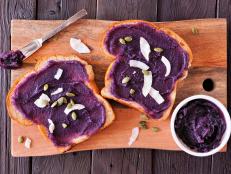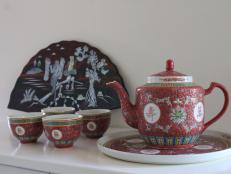How I Celebrate My Asian American Heritage with a Big Bowl of Spaghetti
Distinct Filipino flavors punch up this humble comfort food recipe.

Photograph by Jerome Grant
As told to Laura Denby
Whenever I need a big bowl of comfort food, I turn to my mom’s spaghetti. No, not that kind of spaghetti. I’m talking about a heaping bowl of Filipino spaghetti made with banana ketchup and Chinese sausage. It’s a crowd-pleasing spin on a traditional Italian-American dish that incorporates the nostalgic Asian flavors and culinary influences that I grew up with, thanks to my outstanding home-cook-of-a-mom. The best part? My kids love it too, and it’s become just as much a part of their childhood as it was mine.
If you’ve never heard of Filipino spaghetti, it’s truly a humble and versatile dish that my mom, Lorna, used to make with whatever she had on hand. Like so many other working mothers, my mom would whip up a big batch of Filipino spaghetti when she was short on time for my friends and I to devour after school. The sauce relies on banana ketchup and tomato paste, which gives it just the right amount of slurp-able tang and sweetness.
Though not as prevalent in the U.S., banana ketchup is a staple in the Philippines and was invented due to a lack of tomatoes and a plethora of bananas. The resulting condiment is sweet, vinegary and perfect on everything from hot dogs to pasta. It’s a sentimental reminder of the flavors that I, and so many other Asian American kids, grew up with. The addition of sweet Chinese sausage and spicy ground pork adds a bit of meaty gaminess and makes the dish filling with an extra kick. Heck, my mom would even throw in some chopped up SPAM or hotdogs and cheddar cheese to round out the dish even further!

Photograph by Jonathan Melendez
Get the Recipe: Mama Lorna’s Filipino Spaghetti
Nowadays, I like to take the Asian-inspired dishes that were a staple in my childhood home and elevate them. Filipino spaghetti is a fundamental dish that will remind so many kids like me of growing up, and I’m thrilled to be able to share these flavors with my own children. It’s so special to watch my kids eat Filipino spaghetti and know that they’re sharing the same food memories that I have. Instead of spaghetti, I use chitarra pasta for a toothsome crunch and a bit of weighty mouthfeel. Though my mom used yellow cheddar every now and then, I top my version with tangy, sharp Parmesan or white cheddar to offset the sweetness of the banana ketchup and the acidity of the tomatoes.
Luckily for me, my wife is also a fantastic cook and likes to draw on her own heritage in the kitchen as well. As a family, we’re truly blessed with the diverse flavors and ingredients that show up on our table every day. Drawing on my Asian American heritage is one of my biggest sources of inspiration in the kitchen, and this Filipino spaghetti is a perfect way to highlight the Asian flavors that my mom, Lorna, instilled in me growing up.
Jerome Grant is a James Beard Award-nominated chef and recipe developer. In 2014, he worked as Executive Chef at Mitsitam Cafe at the National Museum of the American Indian, and in 2016, Jerome was named inaugural Executive Chef at Sweet Home Café at the National Museum of African American History and Culture, which received a James Beard Award nomination for “Best New Restaurant” in 2017, and “Best Chef: Mid-Atlantic” in 2019. Jerome's Filipino, Caribbean and Jamaican roots are reflected in many of the dishes he creates. He currently works as Corporate Chef for Dacha Beer Garden and Jackie Restaurant in Washington, D.C.
Related Links:

































